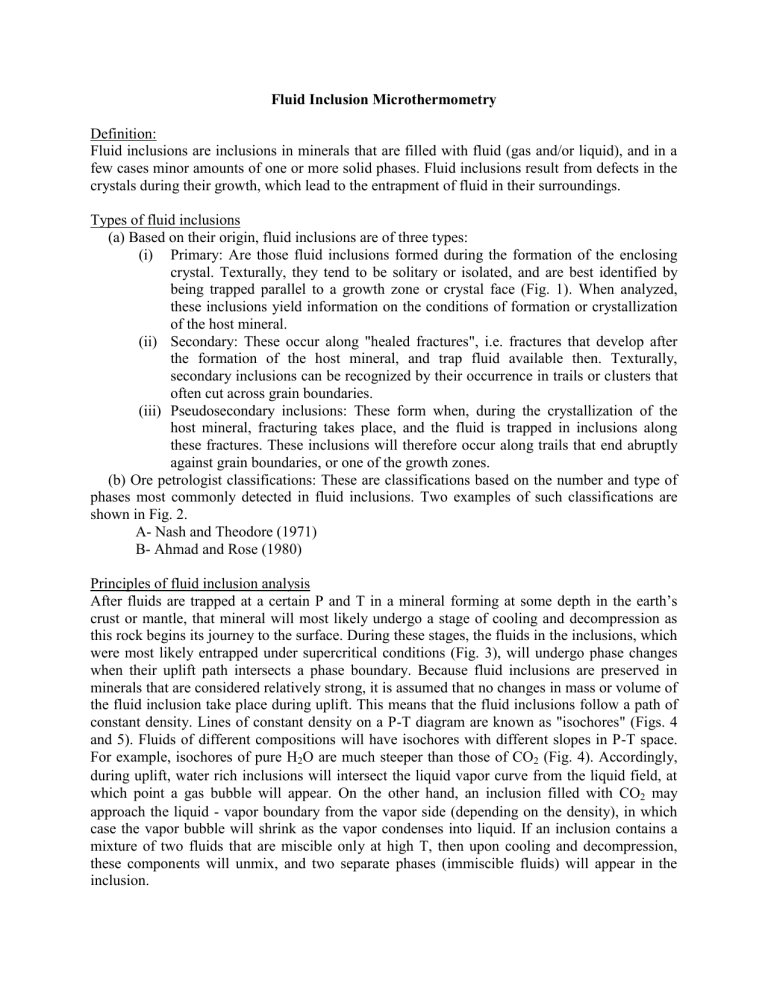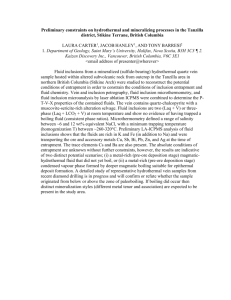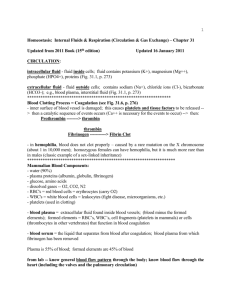Microthermometry of fluid inclusions

Fluid Inclusion Microthermometry
Definition:
Fluid inclusions are inclusions in minerals that are filled with fluid (gas and/or liquid), and in a few cases minor amounts of one or more solid phases. Fluid inclusions result from defects in the crystals during their growth, which lead to the entrapment of fluid in their surroundings.
Types of fluid inclusions
(a) Based on their origin, fluid inclusions are of three types:
(i) Primary: Are those fluid inclusions formed during the formation of the enclosing crystal. Texturally, they tend to be solitary or isolated, and are best identified by being trapped parallel to a growth zone or crystal face (Fig. 1). When analyzed, these inclusions yield information on the conditions of formation or crystallization of the host mineral.
(ii) Secondary: These occur along "healed fractures", i.e. fractures that develop after the formation of the host mineral, and trap fluid available then. Texturally, secondary inclusions can be recognized by their occurrence in trails or clusters that often cut across grain boundaries.
(iii) Pseudosecondary inclusions: These form when, during the crystallization of the host mineral, fracturing takes place, and the fluid is trapped in inclusions along these fractures. These inclusions will therefore occur along trails that end abruptly against grain boundaries, or one of the growth zones.
(b) Ore petrologist classifications: These are classifications based on the number and type of phases most commonly detected in fluid inclusions. Two examples of such classifications are shown in Fig. 2.
A- Nash and Theodore (1971)
B- Ahmad and Rose (1980)
Principles of fluid inclusion analysis
After fluids are trapped at a certain P and T in a mineral forming at some depth in the earth’s crust or mantle, that mineral will most likely undergo a stage of cooling and decompression as this rock begins its journey to the surface. During these stages, the fluids in the inclusions, which were most likely entrapped under supercritical conditions (Fig. 3), will undergo phase changes when their uplift path intersects a phase boundary. Because fluid inclusions are preserved in minerals that are considered relatively strong, it is assumed that no changes in mass or volume of the fluid inclusion take place during uplift. This means that the fluid inclusions follow a path of constant density. Lines of constant density on a P-T diagram are known as "isochores" (Figs. 4 and 5). Fluids of different compositions will have isochores with different slopes in P-T space.
For example, isochores of pure H
2
O are much steeper than those of CO
2
(Fig. 4). Accordingly, during uplift, water rich inclusions will intersect the liquid vapor curve from the liquid field, at which point a gas bubble will appear. On the other hand, an inclusion filled with CO
2
may approach the liquid - vapor boundary from the vapor side (depending on the density), in which case the vapor bubble will shrink as the vapor condenses into liquid. If an inclusion contains a mixture of two fluids that are miscible only at high T, then upon cooling and decompression, these components will unmix, and two separate phases (immiscible fluids) will appear in the inclusion.
To study phase transitions in fluid inclusions, a doubly polished thin section is prepared, then broken into small chips that are mounted on a special heating and freezing stage. These chips are then observed while the stage is either heated or cooled, and the phase changes which take place during a heating or cooling cycle are carefully recorded along with the temperatures at which such changes occur.
Measurtements and inferences: (Fig. 5)
Freezing point depression (Tm f
)
First melting (Tm e
)
Homogenization temperature (T h
)
"Pressure" correction
Temperature of entrapment (T
Decrepitation temperature t
)
Information derived from fluid inclusions
(a) Fluid composition
: This information is gained indirectly from measuring the “first melting temperature (also known as the eutectic melting T or T me
)”. After freezing the inclusion, it is heated slowly while being carefully observed under the microscope.
The temperature of first melting of solid (ice) is recorded (and is usually marked by the first movement of the bubble; Fig. 6). Comparing this temperature to eutectic melting points on published phase diagrams for binary and ternary systems (e.g. Fig.
7) would allow you to predict the composition of the fluid. Fluid composition can also be determined by laser microRaman Spectroscopy (Fig. 8). Finally, the inclusions can be physically "opened" or crushed, and the fluids can be chemically analyzed.
(b) Salinity of the fluids : The stage is cooled with the help of liquid N
2
during which time phase changes in the inclusion are carefully monitored. After the liquid in the inclusion completely solidifies, the stage is heated slowly while the inclusion is observed. The temperature at which the last piece of solid melts (Tm f
) is then recorded (Fig. 6). This will correspond to the freezing temperature of the inclusion.
Knowing the freezing points of pure H
2
O and CO
2
, the recorded freezing point (Tm f
) is "plugged" into an equation of state (one of the form: PV= nRT), and the freezing point depression for the system in question is then directly related to the amount of
"impurities" in this system, providing us with some information on the concentration of salts in this fluid (i.e. salinity of the fluid).
(c) Fluid Density : The density of the fluid can be calculated from knowledge of the Tm f and T h
. Plugging these values into equations of state for fluids of known composition
(i.e. knowing which system to deal with) would allow you to determine the density of the fluid, and calculate isochores.
(d) Temperatures of entrapment : Microthermometric techniques rely on heating two - phase inclusions on the stage until they homogenize (i.e. change to one phase). The temperature at which homogenization takes place can therefore be considered a
"minimum T" for fluid entrapment. If the pressure of entrapment (or mineral formation) is known by some independent means (e.g. phase relations or geobarometry), then the temperature of entrapment can be immediately determined by the intersection of the isochore passing through the homogenization T with this
pressure. The difference between the homogenization T and the T of entrapment is known as the "P correction" (even though it has nothing to do with P!; Fig. 5).
(e) P-T history of the sample : The textural relations exhibited by a particular fluid inclusion assemblage often give clues as to the P-T history of the sample. For example, significant isothermal decompression would cause some of the larger inclusions to “explode” resulting in a decrepitated inclusion surrounded by a number of satellite inclusions around it. Isobaric cooling can also produce distinct textures.
Assumptions
Microthermometric studies rely heavily on the validity of two assumptions:
(a) no leaking or necking since entrapment. If an inclusion shows evidence of necking, it should not be used for microthermometry.
(b) the inclusion followed a path of constant density along one of the isochores for the system in question (Figs. 4 & 5).
Fig. 1: Fluid inclusion assemblages: i= indeterminate; origin unknown; p: primary; ps: pseudosecondary; s: secondary
Fig. 2: Phase diagram for the system:
H
2
O. Solid lines and curves represent phase boundaries. Note that there are no discontinuities in properties of
H
2
O across the dashed lines.
P t
1.0
0.5
Liquid
Isochore
(g/cc)
Critical point
T t
350
Vapour
0
50 150
T h http://www.kingston.ac.uk/esg/facilities/fluidinc.ppt
Fig. 5: P-T diagram showing changes occurring in a fluid inclusion as the rock is cooled and decompressed along an isochore and a phase boundary. P t
: entrapment pressure; T t
: entrapment T; T h
: homogenization T. Note that the difference between T h
and T t
is known as the “pressure correction”.
Fig. 6: Phase behavior of a H2O – NaCl inclusion as it is heated from -46°C to -7°C. The first frame represents the phase relations as observed at 25°C.
Fig. 7: Vapor saturated phase relations in the system NaCl-H
2
O from Bodnar (2003). I= ice; L= liquid; HH= hydrohalite; H = halite; P= peritectic point; E: eutectic melting point (-21.2°C; 23.2%
NaCl).
8000
R-20-I-R
6000
CH
4
CO
2
4000
2000
N
2
1000 1500 2000 2500 3000 3500 wavenumber (cm
-1
)
Fig. 8: Micro-Raman spectrum of a fluid inclusion from a Au-bearing quartz vein, Umm Egat,
Egypt. A.U. absorption units.







